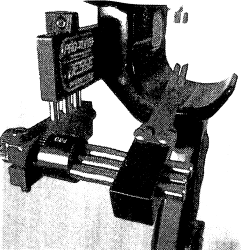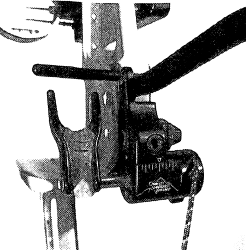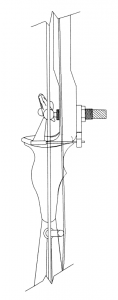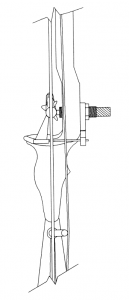The deciding factor for any equipment you use will be the groups you shoot.
Arrow rests come in as many types as there are claims about them. Their manufacturers make many claims about the arrow flight which is supposed to occur and the groups which will cluster in the center of the target when you use their rest. Many of these claims are justified and many of the rests on the market will work reliably. But, like many other products, not all rests will work well for you. Maybe there is only one style or make of rest that will work well for your bow the way you like to shoot it.
It is not the purpose here to look at specific brands of rests. Instead, we need to look at two major types of rests. For the want of better names, I will call them “shoot around” rests and “shoot through” rests.
The shoot-around rest requires that the arrow bend around and pass to the left side (for right-handed shooters) of the rest. Since every arrow that is shot from a bow must bend, to some degree, through paradox as it passes by the arrow rest, the shoot-around rest is at no great disadvantage.
Some of these brands of rests however, do not have side tension and down tension which can be controlled. For example, the springy is a single unit rest and cannot be altered, as the cushion plunger can be, to try different tensions for tuning. You can try springy rests of different tensions, but sometimes a finer degree of change is desired. Please keep in mind that if one of these rests makes good groups for your bow — and you like all other things about it — then that is the rest you should be using. The deciding factor for any equipment you use will be the groups you shoot.
The shoot-through type of rest provides support on the side of the arrow and also on the bottom outside of the shaft. This type of rest is better suited for the release aid since most arrows shot by release aids leave the bow with less bending motion (paradox). Most shoot-through rests provide the capability of altering side tension and vertical tension. Either can be adjusted independently of the other.
Although the shoot-through rest is my personal choice and has provided my highest scores, it also has some disadvantages. At the top of this list is the fact that most arrows will leave the rest nock-end high. Some archers also have problems with the arrow falling down into the rest prior to the shot.
Arrow rest selection is an ongoing process. Each bow you use may require a different rest to get the best results from it. Your shooting form may change as you practice, and a rest change may improve your groups.
No matter what rest you use, you will need to be concerned with its location on the bow. Arrow rest location is commonly referenced relative to degree of center shot. Center shot adjustment is the left-right movement of the arrow rest.
To establish the center of the bow you must rely on the center of the handle riser and not the center of the limbs. The center of the riser is the center of gravity for the bow because of the handle riser weight. The arrow, therefore, tends to travel through the lateral center of pressure. Generally, the center line runs through the center of the grip section of the riser.
Center-shot adjustment is one area where the metal riser is far superior to the wood riser. A metal riser can be manufactured away from this center line to allow clear passage of the arrow. The wood riser must be cut with enough material remaining in this center line to maintain adequate handle strength. Remember, the arrow tends to shoot through the center line, and if the handle is in the way a number of tuning problems will result.
Most finger shooters I know adjust their rest so that the arrow rides just to the outside of the center line. This enables the arrow, particularly the nock end, to clear the rest while it is bending through paradox on its way past the riser. Begin with this rule of thumb, but don’t hesitate to experiment with other positions.
The majority of release aid shooters position their rest so the arrow is riding directly through the center line of the riser. When shot with a release aid, an arrow tends to bend far less through paradox than an arrow shot with fingers.
My personal experience with center shot adjustment leads me to the conclusion that little is accomplished by moving it from the positions mentioned above. So, I place my rest accordingly and move on to more important things.
Some thought should be given to the forward-rearward location of the rest. The compound bow riser is designed so the rest is located above or nearly above the pressure point of the grip. Moving the rest forward or rearward of the grip pressure point has the effect of magnifying poor hand position and hand torque. The overdraw rest is the classic example of this situation. Turning or twisting the riser upon release causes a significant left or right movement of the rest relative to the grip and to the sight. The result is an unexpected left or right impact point in the target. Be aware of this condition if you plan to use an overdraw rest assembly.
by Larry Wise, International Archery Champion & Archery Coach
(Paperback, 5-1/2” x 8-1/2”, 152 pages)
Invaluable bow tuning & shooting tips! High performance tuning for all cams, all compounds!

LAUNCHER ARROW REST — The Launcher style arrow rest is the most popular rest for compound bow target shooting. It has a single flexible steel blade with superior memory and accommodates the vertical flexing of the arrow.

DROP-AWAY ARROW REST — The Drop-Away style arrow rest is the most popular for hunting with a compound bow. The support blade of fingers drop away after the arrow travels three to six inches on its launch path so that the fletching passes cleanly over the rest with no contact.

The metal riser, left, can be made so the arrow will pass above the center line of the grip. The wood riser, right, must not be cut away over the center of the grip so handle strength is retained.

This drawing shows an arrow resting just to the left (for right-handed shooter) or outside of the center line of the grip.

Most release shooters adjust their arrow rests so the arrow is in the center line of the grip, as shown here.


 TUNING YOUR COMPOUND BOW
TUNING YOUR COMPOUND BOW